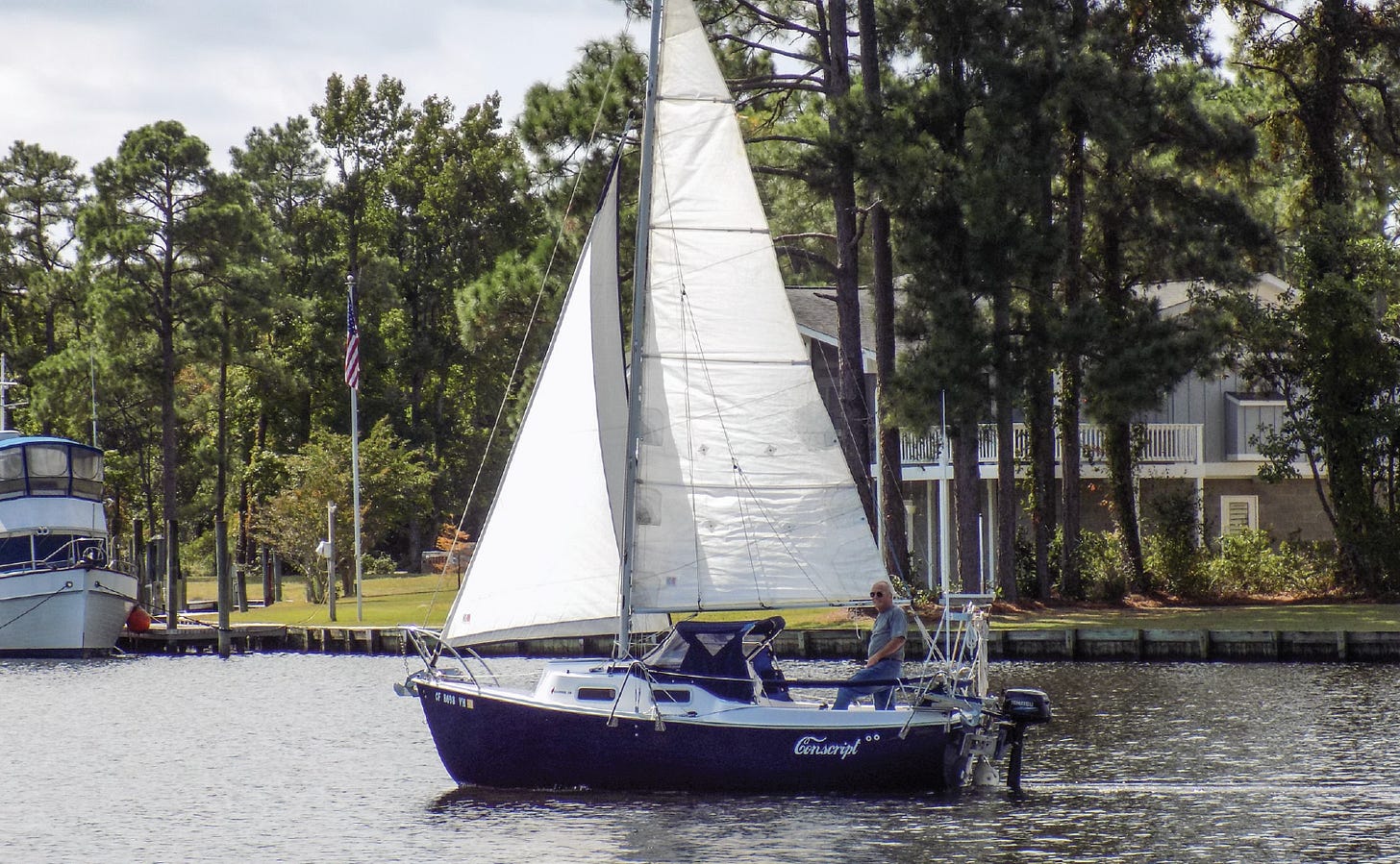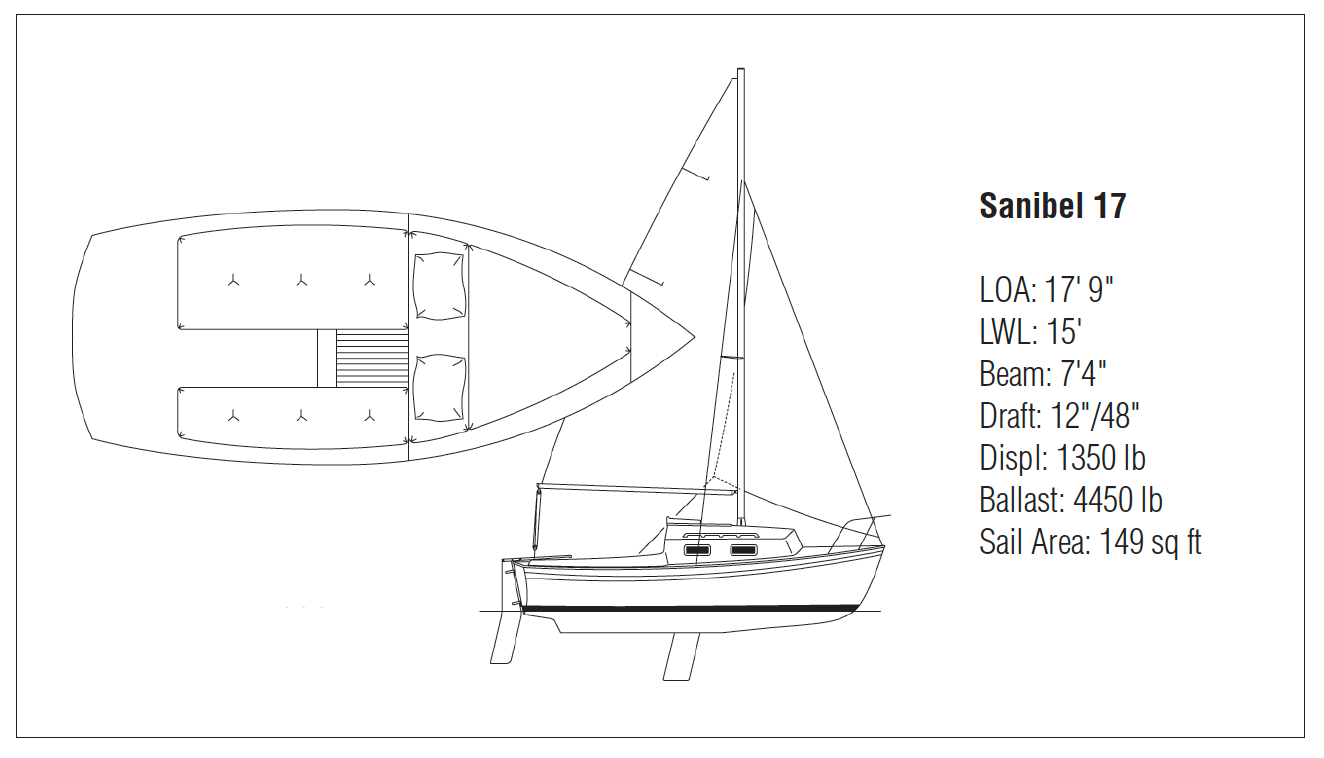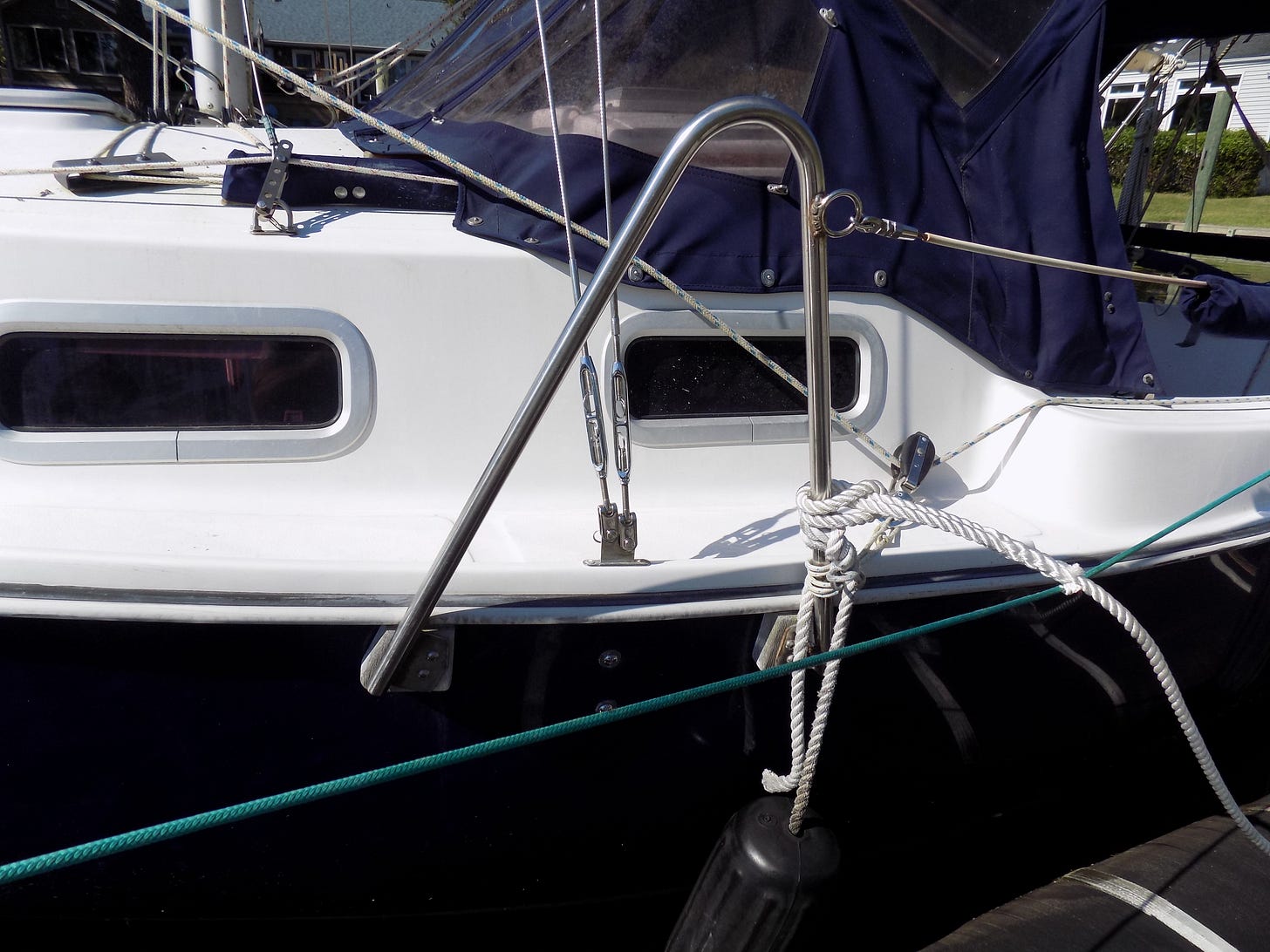Article by Phil Truitt
I began sailing the Santa Barbara Channel in 1982—aboard friends’ boats, my own boats (four), chartered vessels, as well as boats that were part of classes I took from time to time. These boats ranged in size from 18 to 50 feet. Over the years I found that I spent a lot more time on the water when I went singlehanded, and I developed a good understanding of what can happen—particularly to those of us who sail on a schedule, or have to go when the time is available and come back when life dictates. And while I love the fancy bigger boats, my experience shows that the rule about boat size is true—that time on the water is inversely proportional to the length of the boat—so I searched for a boat as small as I could be comfortable in; that was capable of some challenging adventures, and that pleased my sense of aesthetics.
The Sanibel 18—a design that’s been made by different builders since 1982—came as close as any to matching my needs, so I bought a new International Marine Sanibel 18 in 2013 and began considering how the stock model could be improved. The boat sailed well as she came, but I wanted the jib to stand better and found that to tension the head stay I had to stiffen the mast, which was an extrusion shared by the Potter 19, among other boats. This was done and I built a centerboard with about 25% more area, and got serious about anchor gear, along with reefing and furling equipment. (I did have one onlooker at the dock comment that the boat was a bit “busy.” I’m sure he meant “overdone,” but it’s likely he never arrived in a rough, windy anchorage cold and tired, and had to secure an anchor by himself. This I can do in minutes without leaving the cockpit.)
I confess that with all the boats I’ve sailed, I’ve learned that if I want a good high average speed, and to arrive on time, it helps not to be bashful when it comes to turning on the “iron genny,” and I do if I need to. This boat has covered more than 500 nautical miles in Santa Barbara Channel, including passages of over 40 miles at an average of just under 5 knots I purchased Conscript with a radio and instruments—a speed log, depth sounder and compass. I added a small solar panel to keep the battery charged, along with manual and electric bilge pumps. It didn’t take long to decide I wanted to be dry more of the time, so the dodger is now my favorite piece of added gear, along with the roller-furler, lazy jacks, cell-phone booster and tiller pilot, which steers Conscript on long passages.
I can almost stand up straight in the hatch under the dodger so that with the drop boards in place, I can take a sponge bath or dress, even tied up in a crowded marina. For the first seven years of use, she stayed in a mast-up yard where she was slung in without further cost. I could arrive, have the boat launched and be gone in a few minutes. In tight spots, she turns and backs like a dream. She can be anchored in such shallow water that no other boat is likely to drag into me, so I can usually get places to myself, or at least be anchored a fair distance from larger boats.
There are a few things that often need help on any boat, and smaller ones are no exception. Jib sheet angles I adjust with snatch blocks. There is no anchor locker, so chain and rope rodes live in mesh bags in the aft port and starboard corners of the cockpit. I have two large padeyes to which I attach a lanyard from my vest if it gets rough. I use anchors a bit larger than specified and they are on rollers, ready to go. I have a laminated wooden block that fastens to the aft starboard seat with thumb screws and a shop-made bracket under the tiller for the tiller pilot. I have no real fear of being washed out of the cockpit the way it now is. The cockpit sun cover cannot be used while sailing but I can cover the cockpit at anchor. I cook and heat coffee on a one-burner propane camp stove and use an ice chest for cold things. I don’t often go ashore in the islands but if there is a sand beach, I can get in so close a pair of shorts and a t-shirt can get me ashore dry.
Some will question the use of such a small boat for the things I have done. All I can say is that water is not our natural environment and any ship or boat can drown you. The Sanibel is ballasted and will come back from a rather deep knock down (which I’ll go to great lengths to avoid). I never had to use it, but I’ve carried a 12-foot parachute anchor. I keep a good DR plot and use my iPhone with a Garmin app for gps navigation. The only shortcoming about the boat is its size, which is also its best virtue.
Now Conscript has moved to the Neuse River in North Carolina, where you could say some of it’s gear is no longer justified. But my little boat goes out a lot more than the larger boats, some of which have owners my age and have not been out in many years. Folks who go out with me are glad to have shade and protection from spray. All lights are LED and can run all night, thanks to the solar panel, as can the VHF radio. The outboard is a 6-hp. Tohatsu which I have learned to trust (given proper maintenance). It can drive her into a stiff headwind or make over 5 knots by itself.
I’m now over seventy with no plans to quit using the boat. I can easily handle any task aboard, and can sit or lie down in the cabin in comfort to pass time or wait for weather. As mentioned, I can stand nearly straight in the open hatch under the dodger. (The actual measured height from cabin sole to dodger is 5'4" and I am 5'10" tall. The off-center CB of the Sanibel and the resulting open footwell in the cabin help. Doesn’t sound like much, but even with foulweather gear one can really appreciate a dry change of clothes after a rough passage. That is much easier under the dodger.
I hope you all get as much enjoyment from your boats!
ADDITIONAL NOTES FROM THE OWNER
Those of us who get to choose the type and vintage of the boats we own are very fortunate. The things we do to make them fit our needs better should have received a head start by our choosing. The adventure of taking what is available to us however, may change the possible modifications but not the adventure itself.
I would divide the desired changes into categories to be able to plan by importance and timing of what to do first. Safety mods, in my opinion, should come first. Things like fire extinguishers, first aid kits, PFD’s, anchors and the like should go in first and will depend on the intended use of the craft. Other needs or desires of the skipper can take any order desired by the owner/skipper since very few of the boats we use come to us with no gear at all. Nearly all boats will come from the manufacturer in functional form in at least a minimal sort of way.
My first changes were for performance and ease of handling under sail. The pictures will show the lazy jacks and furler, but they cannot show why. I started with a downhaul and a fully battened mainsail, but experienced a full list of minor disasters —including blown out jibs and sails in the water at inopportune times. Being alone aboard any boat will sober a sailor more quickly as the wind rises, the distance to safety increases, and the water temperature drops. I was planning to be out around the Santa Barbara Channel Islands.
Conscript has a backstay, fractional forestay and upper and lower shrouds without spreaders. I stiffened the mast by riveting a 12’ x 3/4” x 3/16” bar of aluminum along the mast’s leading edge from just below the headstay fitting down as far as it went. Then added a quick release backstay tensioner. That worked wonders for the headstay tension. The furler and lazyjacks went on after only a sail or two. A couple of near twenty-mile crossings later, the plans for cockpit protection and controlled anchor handling became priorities.
Conscript came home from the factory with a small solar panel on the sliding hatch, which can still be seen. It worked fine, and the battery never had to be hooked up to shore power, but when designing the layout for the cockpit with dodger and anchor gear, the need for a different solar panel location as well as cockpit security inspired the arch. The panel size was increased to allow the Tiller Pilot to steer without running the batteries down.
I will go down the list of mods, with the disclaimer to safety items should be left up to the skipper.
The furler is the smallest from CDI (Cruising Designs). One can only expect so much from any hardware when used differently than intended. Conscript’s jib is approximately 110%, and the ¾ fractional rig means it is very small. I am confident of two things. 1. It’s up to the job. 2. If I were the manufacturer I would not honor the warranty as I am using it. It’s designed to use a line that is essentially a shoe string in size and only over-wrapped, not fixed in any other way. This will allow you to furl the jib but not put much strain on it. Without knowing both the exact size of the jib, and the way the sailor is using it, the designer cannot predict loads on the furler. I’m using a very small jib with only a minimal overlap, hence a need for less furling line length. By doing this I end up with enough room on the furling drum for a much thicker line. One I can haul on easily. I examined the drum with the furler disassembled and determined I could safely drill through it and knot the line inside so that it will not come off. I have been “reefing” Conscript’s jib for nearly ten years without a failure of any furler parts. The pictures will show the line is just over ¼”. All halyards, the furling line and the lazy jack lines are led to the cockpit by way of the coach roof. I use a topping lift that is one length of line from the masthead to about two feet above the boom, and added a two part block/line from there to the end of the boom so that I can manipulate it easily while at the helm. I used a kit from Nautos, the one for which I supplied the line, for the lazy jacks. I do have to tend the mainsail leech to some degree as the sail goes up to avoid fouling the batons in the lazy jacks. It’s definitely worth it! I can lower the sail from the cockpit without a lot of effort. Hence I can reef even if I’ve waited a bit too long, which I do not recommend. Through an access in the dodger wind screen I can get to the vang, boom downhaul, and forward reefing hook. I use multiple sail track stops,(or nuts) to keep the sail from leaving the track.
Anchoring can be easy and even pleasant under good conditions. It can be absolute hell for one person in a very small boat under rough, high wind conditions! If I am unpleasantly surprised by conditions in my anchorage, I drop the stern anchor as close to the ideal place as I can, set it. Clean up the deck and then begin preparations for putting down the bow anchor. It can get so bad that I have set both anchors off the stern, port and starboard, and gone to bed. Conscript has enough freeboard aft to keep almost anything out, but the transom will pound if being hammered by waves.
On deck you will notice, in addition to the arch and dodger, a pair of what I refer to as, “A frame” stanchions. They’re far stronger than a single post and can have a lot of tension on them with no problem. The area under them was filled with epoxy between the hull and liner and they are through-bolted. I do not like the interference of a lifeline forward, and there are plenty of grab holds, so the lifeline only goes aft from the stanchion. There is a stainless ring welded to the stanchion near the bottom to accommodate the snatch blocks that allow me to adjust the jib sheet leads.
The arch is designed to unpin and fold down for trailering. There’s a teak block on the arch to support the mast when down or trailering. The bottom of the arch is a pair of the “A” frame stanchions with hardware added to do the various thing needed. While I stated that you can build the dodger frame without welding, and I suppose to some degree the same is true for the arch, the pads on the stanchions must be welded and I have used the same for some of the other items.
I also built a modified centerboard but feel most of us won’t need that, and those who feel compelled will have their own ideas about how to go about it
I built a small seat which can be seen in the picture from the port quarter to go over the lip of the companionway so that I can sit there out of the spray, with the tiller pilot control in my hand. Things can easily get too rough for the tiller pilot on Conscript.•SCA•











You must be so proud of what you have accomplished.
Phil...you did it correctly, keeping it simple and functional for all conditions of sail. She is beautiful and close to perfection. One day you will have to sell her, so find me, if still alive, to allow me to become the next proud owner! JimBarden
Where did your source those stanchions? I think I would like something like that.